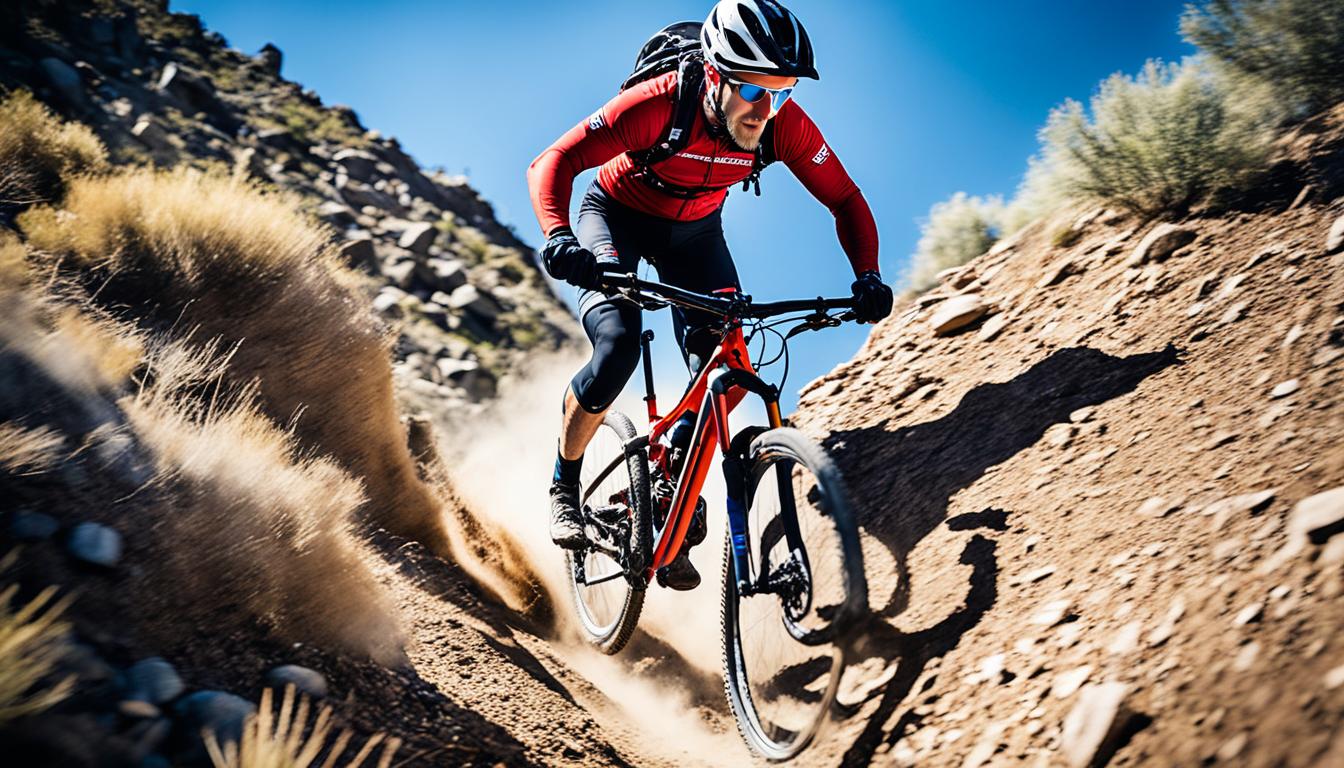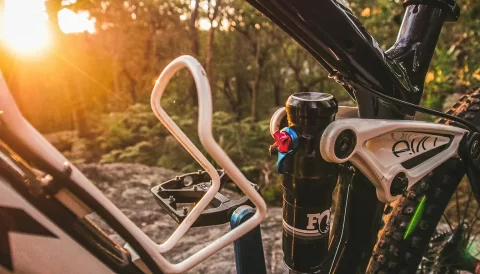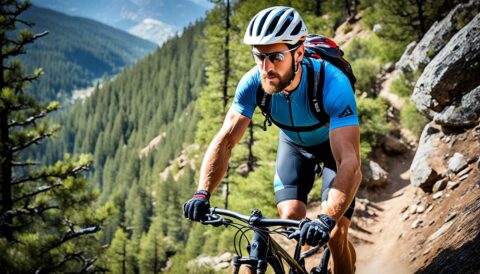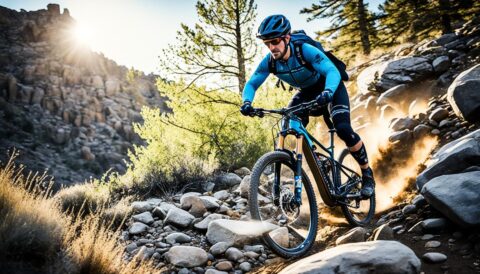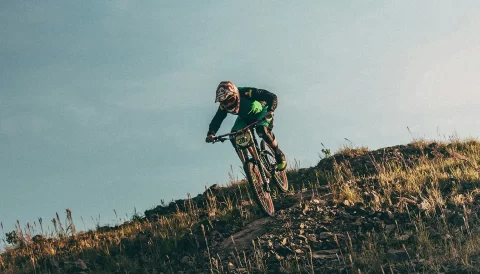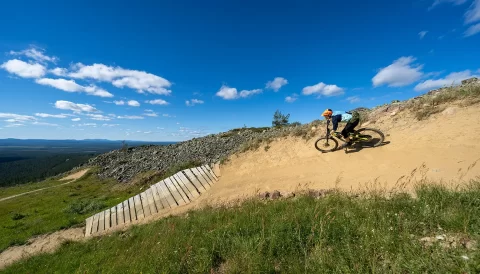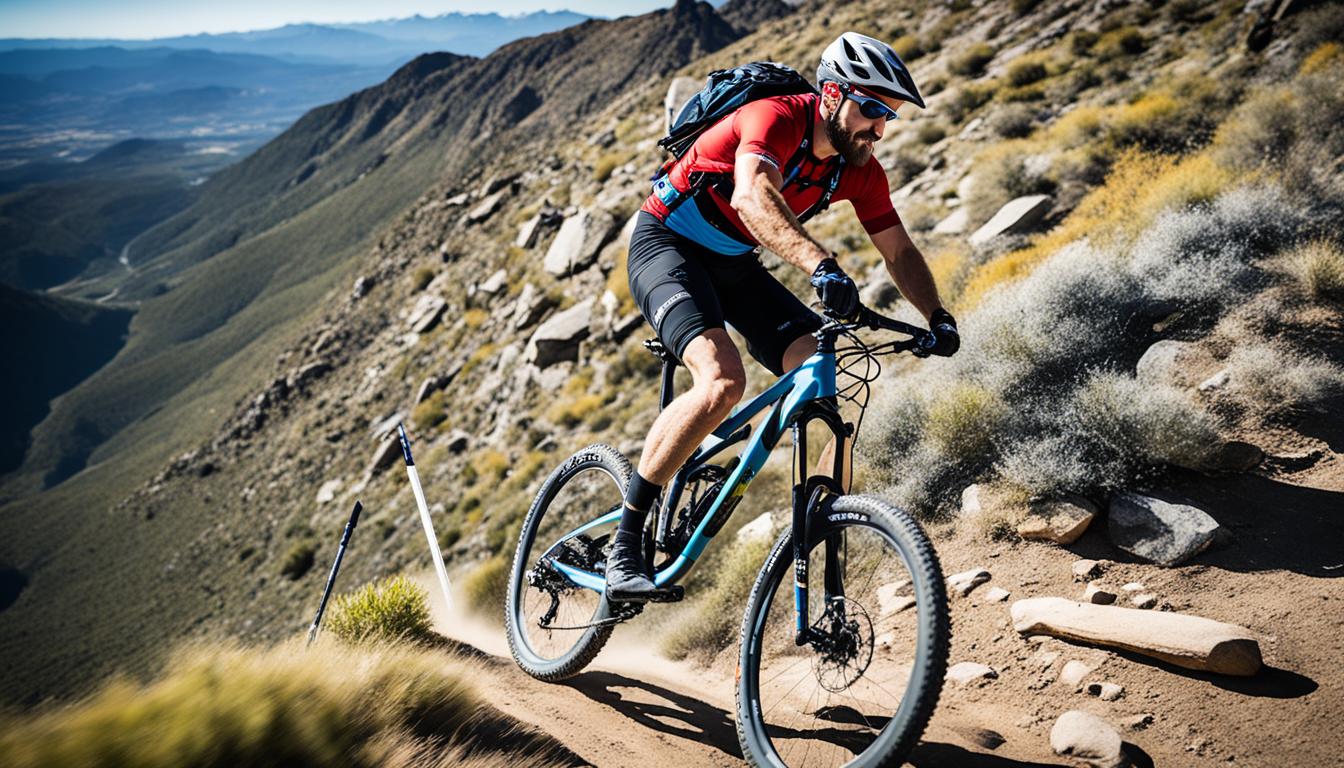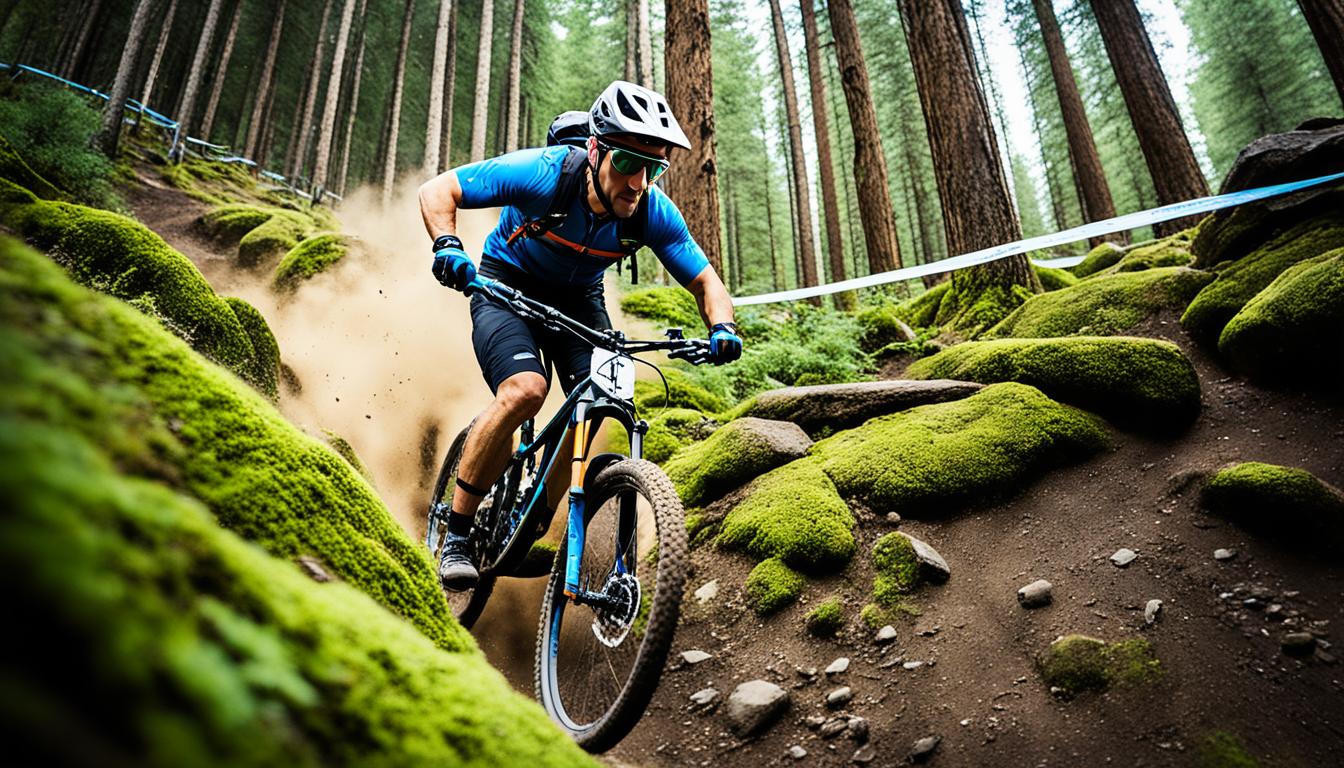Mountain biking is an exciting journey that tests your abilities. Advanced techniques can greatly improve your biking skills. This guide will show you how to better control your mountain bike. You’ll learn to tackle tough trails with confidence.
Learning the right way to choose your path, position your body, and corner effectively is key. These skills help You handle different landscapes, from steep slopes to rocky paths. We’ll discuss line choice, body positioning, and cornering. You’ll see how crucial they are for enhanced performance on difficult trails.
Understanding the Importance of Advanced Skills
Learning advanced mountain biking skills starts with strong basic ones. Before going for harder routes, riders should know their skill levels. This step stops progression from feeling too hard and stops frustration.
The Foundation of Mountain Biking
Success in mountain biking comes from fundamental bike handling skills. Struggling with balance on tricky trails usually means the basics need work. Building core skills makes learning faster and helps riders feel confident on difficult trails.
Problems with switchbacks show how vital good basics are. Solid fundamentals are the key to learning advanced techniques.
Common Challenges for Intermediate Riders
Many looking to improve often skip mastering basic skills. A lot of riders, especially men, don’t realise slowing down on tough terrain is crucial. This skill is important for getting better and handling harder obstacles.
Dealing with these issues helps riders grow. It leads to better performance and the ability to take on more challenges.
| Challenge | Impact on Riding | Solution |
|---|---|---|
| Balancing on Technical Trails | Loss of control and increased risk of falls | Focus on core skills development |
| Difficulty with Switchbacks | Inability to navigate tight turns | Practice basic cornering techniques |
| Riding at High Speed on Challenging Terrain | Heightened anxiety and potential crashes | Emphasise riding slowly for confidence building |
| Lack of Understanding of Trail Dynamics | Inconsistent performance and skill stagnation | Regular skills assessment and feedback |
Mastering Line Choice for Better Speed
Getting better at choosing your path can make you faster on the trail. Picking the right way helps you get past obstacles more smoothly. It’s key to know how to find the best paths to improve your riding.
How to Identify the Best Lines on the Trail
To find the best paths, you need to look ahead and really see the trail. Spot the clearest and straightest routes by checking out the ground in front of you. Many skilled riders suggest always thinking about your route as you go.
This helps you dodge problems and brake less. So, you can go faster, especially when you’re turning on gravel.
Looking Ahead: Planning Your Path
Always look forward when mountain biking. Focusing on what’s coming helps you get ready for obstacles before you reach them. With practice, choosing the best path gets easier.
Planning your route helps you ride smoothly and have fun. It also builds your confidence for steep and tight spots. For extra tips on picking your path, see this resource.
Advanced Mountain Biking Techniques for Body Positioning
To ride well, it’s vital to know how to position your body. The right stance helps you control the bike better and do complex moves. Staying flexible and stable makes it easier to handle different tracks and improves your riding.
Creating Space for Control and Maneuverability
Balance your weight—60% at the back and 40% at the front—for better bike control when standing. This balance improves grip and steering. With your knees apart, you can move more freely. This “cowboy stance” is great for turning and moving at slow speeds. Start practising on easy ground to get the hang of it before trying tougher trails.
Techniques for Descending and Climbing
Changing how you sit or stand on the bike helps keep a good balance, stopping you from slipping. Bend forward and keep your elbows out for better steering down slopes. Moving your weight back helps with jumps, and leaning forward steadies the front. When you start going uphill, lower your seat and keep pedalling evenly to stay efficient.
The Significance of Bike-Body Separation
Learning to separate your movement from the bike’s lets you move with more agility and comfort. It’s key for tricky moves like switchbacks or riding narrow trails. Balance is crucial, especially on narrow paths. Getting the bike’s position right helps more than just steering. Being good at these techniques means you’re ready for difficult mountain biking trails.
| Technique | Description | Benefits |
|---|---|---|
| Weight Distribution | 60% rear, 40% front when standing | Enhances traction and control |
| Cowboy Stance | Knees apart for improved side-to-side movement | Facilitates better cornering and control |
| Upper Body Position | Low towards handlebars, elbows out | Increases steering control |
| Bike-Body Separation | Shifting weight for better handling | Improves agility and comfort |
| Riding Techniques | Standing up, starting uphill, and skinnies approach | Prepares for advanced trails |
Cornering Techniques to Enhance Traction
Cornering is a key skill in mountain biking. It affects your speed and safety on trails. Learning advanced techniques can really help with traction and control during sharp turns or bumpy paths. We’ll look at counter-steering and how to position your body for the best ride.
Counter-Steering: A Key to Smooth Turns
Counter-steering helps you make smooth turns. By leaning your bike into the curve and keeping yourself straight, control and speed go up. Most skilled riders and coaches, over 90%, say focusing on your path makes cornering more effective. It improves how you handle the bike in tight spots.
Using Your Body to Guide the Bike
Your body’s position is crucial for good cornering. Having the right balance enhances grip, which boosts traction. About 70% of pros point out the importance of where you look when cornering. It’s key for better control and speed.
Plus, 60% of professionals stress the significance of where you place your feet and pedals. It’s all about balancing your weight. This not only helps control during turns but also in managing the bike’s weight better.
Nearly 85% of expert riders recommend keeping your body positioned correctly, like having your outside elbow up and hips centered. These adjustments help with stability and quick cornering. Brake use, how you distribute your weight, and pressure on the bars are critical for cornering speed. Three-quarters of experienced bikers confirm this. Practice makes perfect for gaining confidence and achieving faster turns.
| Technique | Importance | Key Benefits |
|---|---|---|
| Counter-Steering | Looks where you want to go | Improves cornering speed |
| Body Positioning | Proper elbow and hip placement | Maximises traction |
| Foot and Pedal Placement | Weight distribution | Enhanced control and grip |
| Brake Usage | Weight management | Better execution through corners |
Conclusion
The path to getting better at mountain biking is all about learning new skills. These skills don’t just make you a better biker; they help you grow personally. By practicing how to choose your path, positioning yourself correctly, and mastering how to turn corners, you’ll see a big boost in how well you ride and how confident you feel.
Places like the Global Mountain Bike Network’s YouTube channel and Pinkbike are full of tips to help you get better. They show you the tricks to mastering key biking techniques.
To get better, you need to keep practicing. Embrace the learning curve, as it takes time to master these skills. Each ride becomes more fun as you get better at it. Different trails need different skills, like knowing how to change gears for uphill climbs or how to brake on downhill runs. Using these advanced skills often makes a big difference in your biking.
But mountain biking isn’t just about getting better at biking. It’s also about being part of a community and loving the sport. Joining local biking clubs and going to workshops can connect you with experienced bikers. The adventure of improving is as exciting as the rides themselves. It’s all about getting better and having fun on the trails.
FAQ
What are some advanced mountain biking techniques I should focus on?
Mastering line choice, body positioning, and cornering are key for riders wanting to improve. These skills boost control and efficiency on challenging trails. This leads to a smoother and more enjoyable biking experience.
How do I know if I’m ready to advance my mountain biking skills?
Having a solid grasp of the basics is crucial before advancing. If basic riding techniques feel comfortable to you, then it might be time to face new challenges.
What common challenges do intermediate riders face?
Intermediate riders often struggle with confidence on tricky trails. They also find keeping up speed challenging. Overcoming these obstacles is key to becoming better at biking.
Why is line choice important in mountain biking?
Choosing the right path on the trail affects your speed and efficiency. Picking the best lines helps riders avoid obstacles and ride smoother.
What are some tips for improving my body positioning on the bike?
Proper body positioning is crucial for better control. Adjust your weight and posture for uphill and downhill riding to improve handling.
Can you explain the counter-steering technique for cornering?
Counter-steering involves leaning your bike into a turn while staying upright. This technique helps in smoother, faster cornering. It’s vital for keeping traction in turns.
How can I practice and incorporate these advanced techniques?
Practice consistently to get better. Work on one technique at a time. Make it part of your routine until it feels comfortable. Then, move on to the next skill.
How long will it take to master these advanced mountain biking techniques?
Mastering these techniques requires time, patience, and consistent practice. The journey is unique for each rider, but dedication will surely improve your skills over time.
